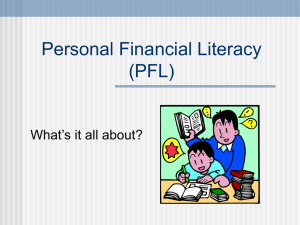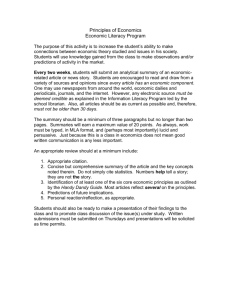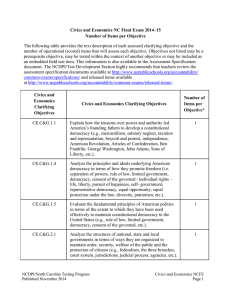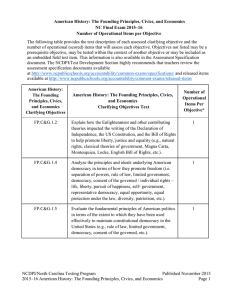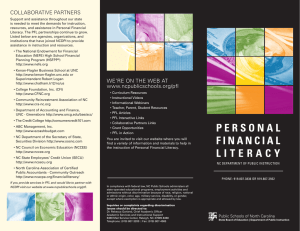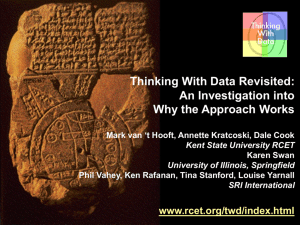Personal Financial Literacy - Public Schools of North Carolina
advertisement
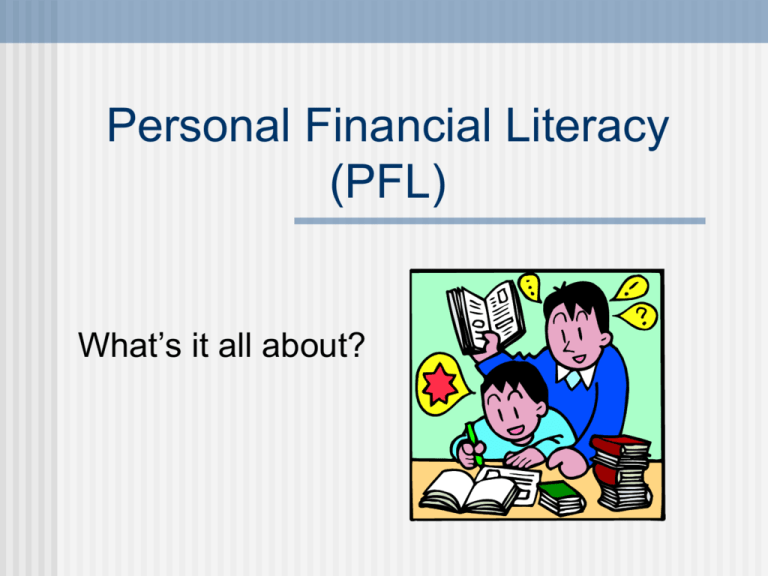
Personal Financial Literacy (PFL) What’s it all about? A Call for Action National Association of State Board of Education North Carolina Department of the State Treasurer The North Carolina General Assembly The North Carolina Department of Public Instruction “The U.S. economy is the eighth wonder of the world. Americans’ ignorance of it is the ninth.” Arthur Levitt Former Chairman, New York Stock Exchange Today’s Teens… Fewer than half of teenagers polled understood how to budget Entering college freshmen have an average debt of $1.500 on personal credit cards. The average credit card debt for college seniors is $2,864; a 48% increase from freshmen Today’s Teens… The average debt of graduating college seniors including student loans is $20,000. Americans under age 25 are filing for bankruptcy faster than any other age group. The News… Personal Financial Literacy is now a requirement in North Carolina Multiple curricula will reflect changes in their NC Standard Course of Study A series of regional workshops are designed for training Support staff includes national partners, local experts and NCDPI Social Studies Consultants Multiple resources and materials are available for instruction NC Legislation SB 622 (2005) Teaching of Personal Finances in Schools HB 1473 (2007) Appropriations Act for teaching PFL in Civics and Economics HB 1474 (2009) Each student shall receive personal financial literacy instruction that include credit, managing a credit card, borrowing money for large purchases, and credit scores and reports SB 1019 (2009) The establishment of a Financial Literacy Council to coordinate and expand the statewide delivery of financial education PFL legislation… How will it affect Social Studies Teachers Students PFL… Civics & Economics courses will include modules of instruction in Credit Savings Investing Checking A pre- and post- survey of Personal Financial Literacy Why Civics & Economics? It is a required course - all students take it PFL should begin early in the HS career Teens purchase Teens have charge cards Teens begin to work by 10th grade Additional courses are available in other content areas Our Resources…2005-’06 Personal Financial Literacy Documents Elementary Middle Secondary Supplemental Secondary Resource Document PERSONAL FINANCIAL LITERACY: ACTIVITIES AND TEACHING STRATEGIES FOR SECONDARY SOCIAL STUDIES Section I - Economic Basics The Four Factors of Production and their Rewards Candy Bar Economics Section II - Taxing and Spending Local Taxes: Where Does All The Money Go? State Taxes: Why Do We Pay the State? Economic Investment in a Community: A Case Study Is There Such a Thing as a Good Tax? Section III - Money Management Dream Life Family Financial Project Section IV - Savings and Investment Investment: Does Money Grow? Section V – Credit Credit: Friend or Foe? Read the Fine Print Section VI – Insurance Insuring Against Risk Insurance: Do We Need It? Section VII – Banking Banks and Consumer Services No Rubber Checks Additional Resources Our Resources…NEFE Our Partners…SECU Provide training to teachers Provide resource materials Provide human resources Are local (over 277 locations throughout NC) Services and materials are free Local Partners… • • • • • • • • CPA’s Certified Financial Planners (CFP’s) & Financial Advisors Insurance Agents Banks & Credit Unions Junior Achievement Non-Profit Agencies Other Government Agencies - HUD, Social Security Administration, Dept of Labor etc. Retired Professionals My Financial Literacy… Budget Busters What If? Are You A Risk Taker?
